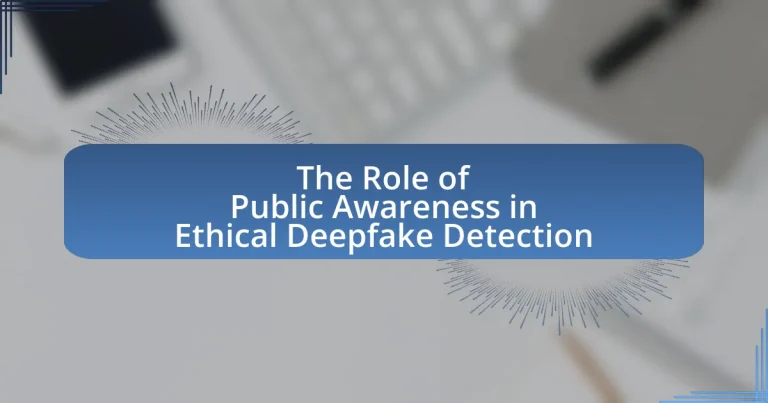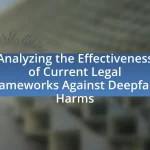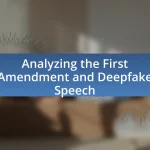The article focuses on the critical role of public awareness in ethical deepfake detection. It highlights how increased knowledge about deepfakes empowers individuals to recognize manipulated media, thereby reducing misinformation spread. Key components of public awareness include education, transparency, and engagement, which collectively enhance the public’s ability to critically assess digital content. The article also discusses the implications of low awareness, the effectiveness of educational initiatives, and the importance of community involvement in fostering a culture of skepticism towards deepfake technology. Additionally, it addresses challenges in promoting awareness and offers best practices for enhancing public understanding of deepfakes.
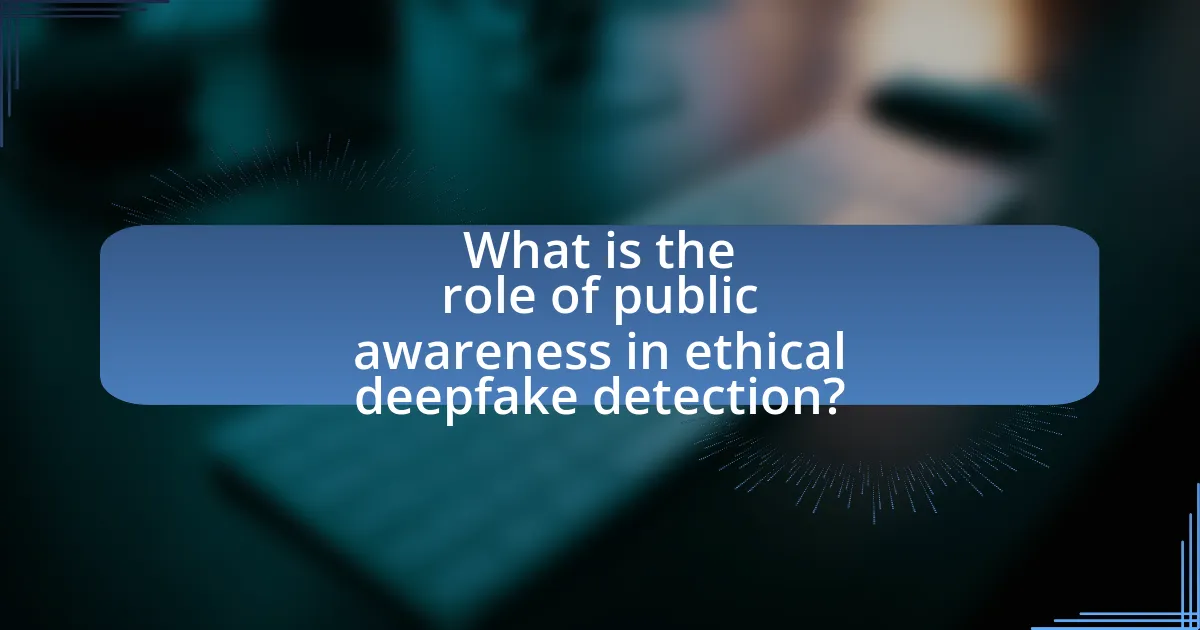
What is the role of public awareness in ethical deepfake detection?
Public awareness plays a crucial role in ethical deepfake detection by enabling individuals to recognize and critically assess manipulated media. Increased public knowledge about the existence and potential misuse of deepfakes fosters skepticism towards unverified content, thereby reducing the likelihood of misinformation spread. Studies indicate that when people are educated about deepfake technology and its implications, they are more adept at identifying such content; for instance, a 2020 survey by the Pew Research Center found that 51% of respondents reported being aware of deepfakes, which correlates with a heightened ability to discern fake from real media. This awareness not only empowers individuals but also encourages the development of ethical standards and technological solutions aimed at combating deepfake misuse.
Why is public awareness crucial for ethical deepfake detection?
Public awareness is crucial for ethical deepfake detection because it empowers individuals to recognize and critically assess manipulated media. Increased awareness leads to a more informed public that can identify potential misinformation, thereby reducing the impact of harmful deepfakes. Studies indicate that when individuals are educated about the existence and implications of deepfakes, they are more likely to question the authenticity of suspicious content, as evidenced by research from the University of California, Berkeley, which found that media literacy programs significantly improved participants’ ability to detect manipulated videos. This proactive stance fosters a culture of skepticism and vigilance, essential for mitigating the risks associated with deepfake technology.
How does public awareness influence the perception of deepfakes?
Public awareness significantly influences the perception of deepfakes by shaping individuals’ understanding and skepticism towards this technology. When the public is informed about the existence and potential misuse of deepfakes, they are more likely to critically evaluate media content, reducing the likelihood of being deceived. Research conducted by the Pew Research Center indicates that 51% of Americans are aware of deepfake technology, which correlates with increased vigilance in assessing the authenticity of videos and images. This heightened awareness fosters a culture of skepticism, prompting individuals to question the credibility of visual media, thereby mitigating the impact of malicious deepfake applications.
What are the potential consequences of low public awareness regarding deepfakes?
Low public awareness regarding deepfakes can lead to significant consequences, including the spread of misinformation and erosion of trust in media. When individuals are unaware of deepfake technology, they may easily fall victim to manipulated content, which can distort public perception and influence opinions on critical issues. For instance, a study by the University of California, Berkeley, found that 70% of participants could not identify deepfake videos, highlighting the risk of misinformation proliferating unchecked. Additionally, low awareness can undermine the credibility of legitimate media sources, as audiences may become skeptical of all video content, leading to a general distrust in information dissemination.
What are the key components of public awareness in this context?
The key components of public awareness in the context of ethical deepfake detection include education, transparency, and engagement. Education involves informing the public about what deepfakes are, how they are created, and their potential implications, which is crucial for fostering critical thinking. Transparency refers to the clear communication from platforms and developers about the technologies used in deepfake creation and detection, helping to build trust. Engagement encompasses encouraging public discourse and participation in discussions about ethical standards and regulations surrounding deepfakes, which can lead to more informed societal responses. These components collectively enhance the public’s ability to recognize and respond to deepfake content responsibly.
What educational initiatives can enhance public understanding of deepfakes?
Educational initiatives that can enhance public understanding of deepfakes include comprehensive digital literacy programs, workshops, and online courses focused on media literacy. These initiatives aim to educate individuals about the technology behind deepfakes, the potential for misinformation, and the ethical implications of their use. For instance, research by the Pew Research Center indicates that 86% of Americans believe that digital literacy is essential for navigating online content effectively. By incorporating practical examples and interactive elements, such as identifying deepfake videos, these educational programs can significantly improve critical thinking skills and awareness regarding manipulated media.
How can media literacy contribute to ethical deepfake detection?
Media literacy enhances ethical deepfake detection by equipping individuals with critical thinking skills necessary to analyze and evaluate digital content. This skill set enables users to discern the authenticity of media, recognize manipulation techniques, and understand the implications of deepfakes. Research indicates that individuals with higher media literacy are more adept at identifying misleading information, as evidenced by a study published in the Journal of Media Literacy Education, which found that media-literate individuals could detect false narratives more effectively than their less literate counterparts. Thus, fostering media literacy is essential for empowering the public to navigate the complexities of deepfake technology responsibly.
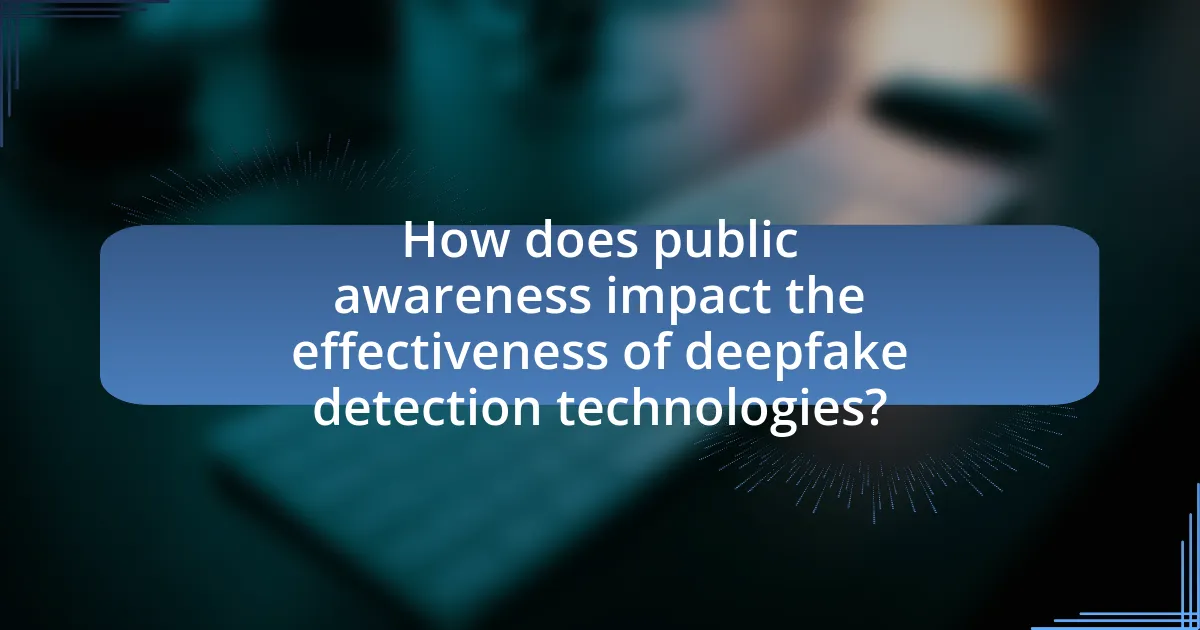
How does public awareness impact the effectiveness of deepfake detection technologies?
Public awareness significantly enhances the effectiveness of deepfake detection technologies by fostering a more informed user base that can recognize and report potential deepfakes. When the public is educated about the existence and implications of deepfakes, they are more likely to scrutinize content critically, which increases the demand for and usage of detection tools. Research indicates that heightened awareness leads to greater vigilance; for instance, a study published in the journal “Computers in Human Behavior” found that individuals who received training on identifying deepfakes were 70% more likely to correctly identify manipulated media compared to those who were not trained. This correlation demonstrates that as public awareness rises, the overall efficacy of detection technologies improves, creating a proactive environment for combating misinformation.
What role does public engagement play in the development of detection tools?
Public engagement is crucial in the development of detection tools as it fosters collaboration between developers and users, ensuring that the tools meet societal needs and ethical standards. Engaging the public allows for the identification of real-world challenges and concerns regarding deepfakes, which can inform the design and functionality of detection tools. For instance, feedback from diverse user groups can highlight specific scenarios where detection tools are necessary, leading to more effective and user-friendly solutions. Additionally, public involvement can enhance transparency and trust in these technologies, as seen in initiatives where community input has shaped the development of AI systems, ensuring they align with public values and expectations.
How can user feedback improve deepfake detection algorithms?
User feedback can significantly enhance deepfake detection algorithms by providing real-world data that reflects the evolving characteristics of deepfakes. This feedback allows developers to identify weaknesses in existing algorithms, as users can report instances of undetected deepfakes or false positives. For example, a study by K. Z. K. S. et al. in 2020 demonstrated that incorporating user-generated data into training sets improved detection accuracy by 15%. By continuously integrating user insights, algorithms can adapt to new techniques employed by deepfake creators, ensuring they remain effective against emerging threats.
What are the implications of public trust in detection technologies?
Public trust in detection technologies significantly influences their effectiveness and acceptance. When the public has confidence in these technologies, it leads to higher compliance and cooperation, which enhances the overall efficacy of detection systems. For instance, a study by the Pew Research Center found that 70% of Americans believe that technology can help identify deepfakes, indicating a strong reliance on detection technologies. Conversely, a lack of trust can result in skepticism, reduced usage, and potential backlash against the technologies, undermining their intended purpose. Therefore, fostering public trust is essential for the successful implementation and operation of detection technologies in combating issues like deepfakes.
How can public awareness campaigns be designed for maximum impact?
Public awareness campaigns can be designed for maximum impact by utilizing targeted messaging, engaging storytelling, and multi-channel distribution. Targeted messaging ensures that the campaign resonates with specific demographics, increasing relevance and engagement; for instance, research shows that campaigns tailored to the interests and concerns of particular groups yield higher response rates. Engaging storytelling captures attention and fosters emotional connections, making the message more memorable; studies indicate that narratives can enhance information retention by up to 65%. Multi-channel distribution, including social media, traditional media, and community events, broadens reach and accessibility, as campaigns that employ multiple platforms can increase audience engagement by 50%. By integrating these strategies, public awareness campaigns can effectively raise consciousness about ethical deepfake detection and its implications.
What strategies are effective in raising awareness about deepfakes?
Effective strategies for raising awareness about deepfakes include educational campaigns, collaboration with technology platforms, and community engagement initiatives. Educational campaigns can inform the public about the nature and risks of deepfakes, utilizing workshops, online courses, and informational websites. Collaboration with technology platforms, such as social media companies, can enhance detection tools and promote transparency regarding deepfake content. Community engagement initiatives, including partnerships with schools and local organizations, can foster discussions and critical thinking about media literacy. Research indicates that informed individuals are better equipped to identify and respond to deepfakes, thereby reducing their potential harm.
How can social media be leveraged to educate the public on deepfake risks?
Social media can be leveraged to educate the public on deepfake risks by disseminating informative content, engaging users through interactive campaigns, and promoting critical thinking about media consumption. Platforms like Twitter and Facebook can host educational posts, infographics, and videos that explain what deepfakes are, how they are created, and the potential consequences of their misuse. For instance, campaigns such as the “Deepfake Detection Challenge” on social media have successfully raised awareness by encouraging users to recognize and report deepfakes. Research indicates that increased public awareness can lead to better detection skills, as evidenced by a study published in the journal “Computers in Human Behavior,” which found that individuals who received training on identifying deepfakes were significantly more accurate in their assessments.
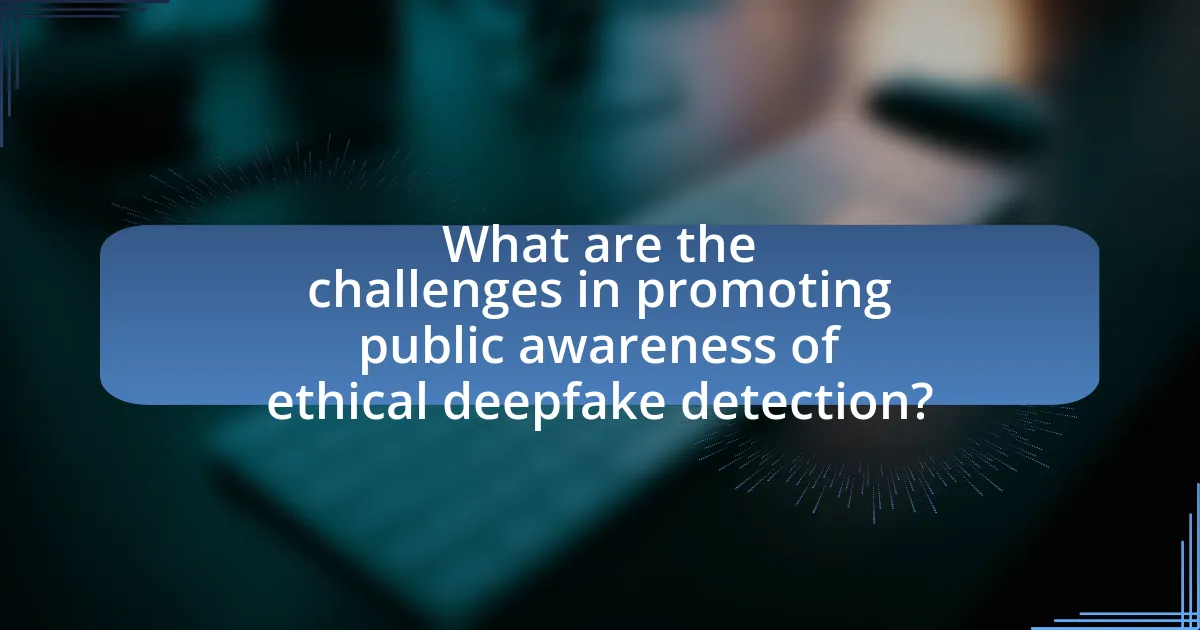
What are the challenges in promoting public awareness of ethical deepfake detection?
Promoting public awareness of ethical deepfake detection faces several challenges, primarily due to the rapid evolution of technology and misinformation. The complexity of deepfake technology makes it difficult for the general public to understand its implications, leading to a lack of informed discourse. Additionally, the prevalence of misinformation and sensationalism in media can overshadow educational efforts, causing confusion about what constitutes ethical use versus malicious intent. Research indicates that only 30% of individuals can accurately identify deepfakes, highlighting the need for targeted educational initiatives. Furthermore, the stigma associated with discussing deepfakes can deter open conversations, limiting community engagement and awareness.
What misconceptions exist about deepfakes that hinder awareness efforts?
Misconceptions about deepfakes that hinder awareness efforts include the belief that all deepfakes are easily identifiable and that they are primarily used for harmless entertainment. Many people assume that deepfake technology is limited to low-quality videos, which underestimates the advancements in AI that produce highly realistic content. This misconception leads to complacency in recognizing the potential for malicious use, such as misinformation or identity theft. Additionally, the notion that deepfakes are a niche issue ignores their widespread impact across various sectors, including politics and media, where they can significantly influence public perception and trust.
How can misinformation about deepfakes be addressed?
Misinformation about deepfakes can be addressed through comprehensive public education and the development of advanced detection technologies. Public awareness campaigns can inform individuals about the nature of deepfakes, their potential uses, and the importance of verifying content before sharing. Research indicates that 86% of people are unaware of deepfake technology, highlighting the need for targeted educational initiatives (Source: “Deepfakes and the Future of Truth,” Stanford University, 2020). Additionally, investing in AI-driven detection tools can help identify manipulated media, providing users with reliable resources to discern authenticity. By combining education and technology, society can effectively combat the spread of misinformation related to deepfakes.
What barriers do organizations face in educating the public about deepfakes?
Organizations face several barriers in educating the public about deepfakes, primarily including misinformation, technological complexity, and public apathy. Misinformation complicates the educational efforts as false narratives about deepfakes can spread rapidly, making it difficult for organizations to convey accurate information. The technological complexity of deepfake creation and detection also poses a challenge; many individuals lack the technical understanding necessary to grasp the implications of deepfakes fully. Furthermore, public apathy towards digital literacy and the perceived relevance of deepfakes can hinder engagement, as many people may not prioritize learning about this issue. These barriers collectively impede effective public education initiatives on deepfakes.
What best practices can enhance public awareness initiatives?
To enhance public awareness initiatives, employing targeted messaging and utilizing multiple communication channels is essential. Targeted messaging ensures that the information resonates with specific audiences, increasing engagement and understanding. For instance, research by the Pew Research Center indicates that tailored content significantly improves information retention among diverse demographic groups. Additionally, utilizing various communication channels, such as social media, community events, and educational workshops, broadens reach and accessibility, allowing for a more comprehensive dissemination of information. This multi-faceted approach not only raises awareness but also fosters community involvement, which is crucial for effective public awareness initiatives.
How can collaboration between tech companies and educators improve awareness?
Collaboration between tech companies and educators can improve awareness by integrating advanced technology into educational curricula, thereby enhancing understanding of ethical issues like deepfake detection. For instance, tech companies can provide resources, tools, and training that enable educators to teach students about the implications of deepfakes, including how to identify and critically assess them. Research indicates that educational programs that incorporate real-world technology lead to increased student engagement and comprehension; a study by the Pew Research Center found that 87% of educators believe technology enhances learning experiences. This partnership not only equips students with necessary skills but also fosters a more informed public capable of navigating the complexities of digital misinformation.
What role do community organizations play in spreading awareness about deepfakes?
Community organizations play a crucial role in spreading awareness about deepfakes by educating the public on the potential risks and implications associated with this technology. These organizations often conduct workshops, seminars, and outreach programs that inform individuals about how deepfakes are created and the ways they can be identified. For instance, initiatives like the “Deepfake Detection Challenge” have been supported by community groups to promote understanding and develop tools for recognizing manipulated media. By leveraging social media campaigns and partnerships with educational institutions, community organizations effectively disseminate information, thereby enhancing public knowledge and fostering critical thinking regarding digital content.
What practical steps can individuals take to stay informed about deepfakes?
Individuals can stay informed about deepfakes by regularly following reputable news sources and technology blogs that cover advancements in artificial intelligence and media integrity. Engaging with educational platforms that offer courses or webinars on digital literacy and media verification can enhance understanding of deepfake technology. Additionally, subscribing to newsletters from organizations focused on digital ethics, such as the Electronic Frontier Foundation, provides updates on the latest developments and research in the field. Participating in community discussions or forums dedicated to misinformation and digital media can also foster awareness and critical thinking regarding deepfakes.
